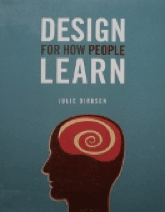 My training in technical writing has motivated me to learn more about the field of instructional design, and I’m always looking for new resources that will help me gain a broader understanding of the topic. In addition, I want to expand my knowledge of current practices in adult learning theory.
My training in technical writing has motivated me to learn more about the field of instructional design, and I’m always looking for new resources that will help me gain a broader understanding of the topic. In addition, I want to expand my knowledge of current practices in adult learning theory.
One of the best books I’ve found so far is Design for How People Learn by Julie Dirksen (New Riders Press, 2012). It’s a fairly slim book, heavily illustrated with photographs, cartoon-like drawings, recipes, mock screenshots and other graphics that effectively relate to the author’s discussion of a given topic. The author writes in a conversational style, using current cultural references and her own experiences to provide real-world context for the ideas she presents.
Identifying knowledge, skill, and motivation gaps
Dirksen offers simple but valuable information to help identify the difference between knowledge and skill: while a learner can acquire knowledge, apply it, and be proficient without practice, a skill requires practice and needs to be developed over time. Similarly, she explains how a motivation gap differs from a knowledge gap: basically, a motivation gap exists if someone knows what to do, but chooses not to do it. Dirksen believes that while learners can’t be forced into being motivated, it is possible for good instructional design to help promote and support motivation.
Teaching, learning, and the context of time
The author also explains why some teaching methods don’t work effectively in time-compressed situations such as GMAT test prep courses. For example, questions that involve problem-solving typically rely on skills such as comprehension, reasoning, and complex analysis—skills that take a very long time to develop. In contrast, questions involving quantitative knowledge tend to utilize information such as math formulas. This type of information can be learned and put to use in a much shorter time.
Summary
The author’s clear and logical explanation of these and many other key concepts provides essential knowledge for both aspiring and experienced instructional designers, and her focused writing style makes the book a quick and engaging read. I recommend Design for How People Learn to anyone interested in learning how to convey information more effectively.
